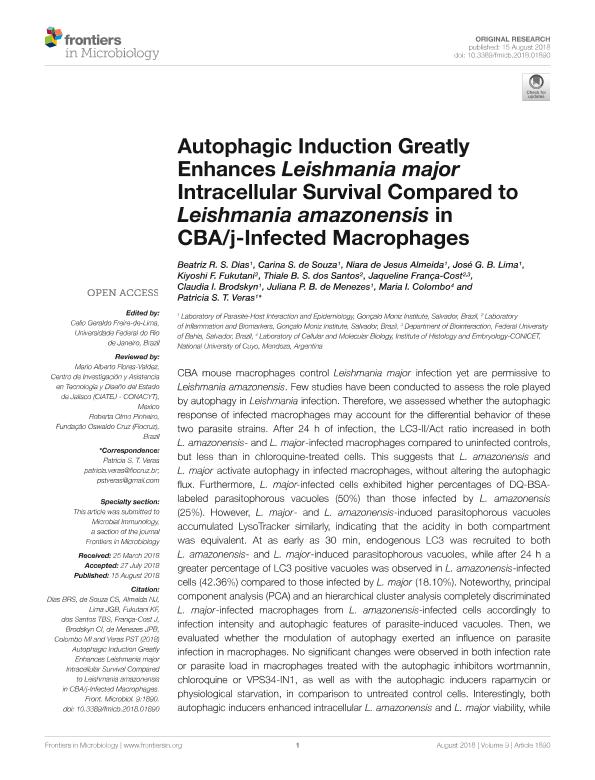Artículo
Autophagic induction Greatly Enhances Leishmania major intracellular survival compared to Leishmania amazonensis in CBA/j-infected macrophages
Dias, Beatriz R. S.; de Souza, Carina S.; Almeida, Niara de Jesus; Lima, José G. B.; Fukutani, Kiyoshi F.; dos Santos, Thiale B. S.; França Cost, Jaqueline; Brodskyn, Claudia I.; de Menezes, Juliana P. B.; Colombo, Maria Isabel ; Veras, Patricia S. T.
; Veras, Patricia S. T.
 ; Veras, Patricia S. T.
; Veras, Patricia S. T.
Fecha de publicación:
08/2018
Editorial:
Frontiers Research Foundation
Revista:
Frontiers in Microbiology
ISSN:
1664-302X
Idioma:
Inglés
Tipo de recurso:
Artículo publicado
Clasificación temática:
Resumen
CBA mouse macrophages control Leishmania major infection yet are permissive to Leishmania amazonensis. Few studies have been conducted to assess the role played by autophagy in Leishmania infection. Therefore, we assessed whether the autophagic response of infected macrophages may account for the differential behavior of these two parasite strains. After 24 h of infection, the LC3-II/Act ratio increased in both L. amazonensis- and L. major-infected macrophages compared to uninfected controls, but less than in chloroquine-treated cells. This suggests that L. amazonensis and L. major activate autophagy in infected macrophages, without altering the autophagic flux. Furthermore, L. major-infected cells exhibited higher percentages of DQ-BSA-labeled parasitophorous vacuoles (50%) than those infected by L. amazonensis (25%). However, L. major- and L. amazonensis-induced parasitophorous vacuoles accumulated LysoTracker similarly, indicating that the acidity in both compartment was equivalent. At as early as 30 min, endogenous LC3 was recruited to both L. amazonensis- and L. major-induced parasitophorous vacuoles, while after 24 h a greater percentage of LC3 positive vacuoles was observed in L. amazonensis-infected cells (42.36%) compared to those infected by L. major (18.10%). Noteworthy, principal component analysis (PCA) and an hierarchical cluster analysis completely discriminated L. major-infected macrophages from L. amazonensis-infected cells accordingly to infection intensity and autophagic features of parasite-induced vacuoles. Then, we evaluated whether the modulation of autophagy exerted an influence on parasite infection in macrophages. No significant changes were observed in both infection rate or parasite load in macrophages treated with the autophagic inhibitors wortmannin, chloroquine or VPS34-IN1, as well as with the autophagic inducers rapamycin or physiological starvation, in comparison to untreated control cells. Interestingly, both autophagic inducers enhanced intracellular L. amazonensis and L. major viability, while the pharmacological inhibition of autophagy exerted no effects on intracellular parasite viability. We also demonstrated that autophagy induction reduced NO production by L. amazonensis- and L. major-infected macrophages but not alters arginase activity. These findings provide evidence that although L. amazonensis-induced parasitophorous vacuoles recruit LC3 more markedly, L. amazonensis and L. major similarly activate the autophagic pathway in CBA macrophages. Interestingly, the exogenous induction of autophagy favors L. major intracellular viability to a greater extent than L. amazonensis related to a reduction in the levels of NO.
Palabras clave:
AUTOPHAGY
,
LC3
,
LEISHMANIA
,
MACROPHAGES
,
PARASITOPHOROUS VACUOLE
Archivos asociados
Licencia
Identificadores
Colecciones
Articulos(IHEM)
Articulos de INST. HISTOLOGIA Y EMBRIOLOGIA DE MEND DR.M.BURGOS
Articulos de INST. HISTOLOGIA Y EMBRIOLOGIA DE MEND DR.M.BURGOS
Citación
Dias, Beatriz R. S.; de Souza, Carina S.; Almeida, Niara de Jesus; Lima, José G. B.; Fukutani, Kiyoshi F.; et al.; Autophagic induction Greatly Enhances Leishmania major intracellular survival compared to Leishmania amazonensis in CBA/j-infected macrophages; Frontiers Research Foundation; Frontiers in Microbiology; 9; AUG; 8-2018; 1-15
Compartir
Altmétricas



